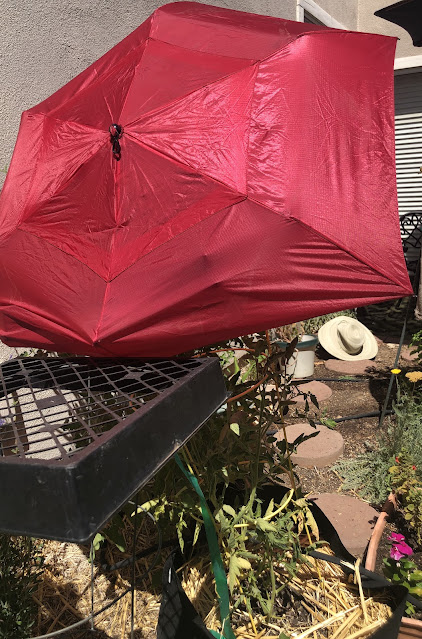
During summer heat, your garden appreciates mulch and morning irrigation

|
|
In addition to the red umbrella shading the tops of a
few tomato plants, how many shade hacks can you
find in this photo? There's the plant flat on a tomato
cage, the straw mulch in the grow bag, an old
summer hat shading the roots of a plant, and just a bit
of the shadows from a shade cloth and a patio umbrella.
That soil could use some more mulch, however. (Photo: Kathy Morrison) |
How is your garden handling the heat? Chances are your plants are faring better than you.
Which is a good thing – people can retreat indoors to air conditioning or at least a spot in the shade. Plants tend to stay in one place, no matter the temperature.
We appear to be in the midst of a record hot summer. According to the National Weather Service, Sacramento averages 23 days a year with triple-digit temperatures. As of Tuesday, Sacramento already had 19 100-plus days, with Wednesday and Thursday all but assured to reach 100 (or more). And this heat wave is not over.
“Temperatures will remain steadily hot into the next week with most days 5-10° above normal,” tweeted the Sacramento office of the weather service on Wednesday. “Hottest days will be today (Wednesday), tomorrow (Thursday) & early next week with Valley temperatures 100-105°. Practice heat safety! Find the forecast for your location at http://weather.gov/sto .”
Ouch! Fortunately, overnight temperatures remain “normal,” dipping down to about 60 degrees each night. That makes mornings automatically more comfortable.
* Get out early and irrigate as needed; some plants definitely will need some extra water.
* Plants with large thin leaves (such as hydrangeas or squash) tend to loose moisture during high heat. Afternoon wilting is normal for these floppy leaves; wilting in the morning is not.
* Container plantings dry out much faster than solid ground; give plants in pots a morning drink.
* If you haven’t already, slip some cardboard or wood under pots to keep their bottoms cooler.
* Organic mulch (leaves, straw, wood chips, etc.) acts as a cooling blanket over bare dirt. It insulates soil, conserves moisture and drops root temperature several degrees. That will comfort your plants during this heat wave and help them survive with less water, too.
* Dust tends to build up on leaves, adding to plant problems. (They can’t “breathe” if their stomatas – tiny pores on foliage – are clogged.) With a hose, give shrubs a morning shower to wash off dust and clean leaves. (It’s not wasting water; the plant will absorb the moisture and excess will run off to the soil and roots.) Do this in the morning so the leaves will dry off during the day.
* Watch for signs of sunburn. Erect temporary shade over tender plants such as peppers or eggplants if necessary. (See the photo above for ideas.)
* Deep-water trees and shrubs as needed. How can you tell if a tree is getting enough water? Look. Use a soil moisture meter to test soil along a tree’s dripline – the furthest reach of its foliage canopy – or try to plunge a long-handled screwdriver 6 inches into the ground. If the soil is like a brick, it’s time to irrigate.
Comments
0 comments have been posted.Sacramento Digs Gardening to your inbox.
Sites We Like
Garden Checklist for week of May 5
Survey your garden after the May 4 rainstorm. Heavy rain and gusty winds can break the neck of large flowers such as roses. Also:
* Keep an eye on new transplants or seedlings; they could take a pounding from the rain.
* Watch out for powdery mildew. Warmth following moist conditions can cause this fungal disease to “bloom,” too. If you see a leaf that looks like it’s dusted with powdered sugar, snip it off.
* After the storm, start setting out tomato transplants, but wait on the peppers and eggplants (they want warmer nights). Pinch off any flowers on new transplants to make them concentrate on establishing roots instead of setting premature fruit.
* Trim dead flowers but not leaves from spring-flowering bulbs such as daffodils and tulips. Those leaves gather energy to create next year's flowers. Also, give the bulbs a fertilizer boost after bloom.
* Pinch chrysanthemums back to 12 inches for fall flowers. Cut old stems to the ground.
* Mulch around plants to conserve moisture and control weeds.
* From seed, plant beans, beets, cantaloupes, carrots, corn, cucumbers, melons, pumpkins, radishes and squash.
* Plant onion sets.
* In the flower garden, plant seeds for asters, cosmos, celosia, marigolds, salvia, sunflowers and zinnias. Transplant petunias, zinnias, geraniums and other summer bloomers.
* Plant perennials and dahlia tubers for summer bloom.
* Don’t wait; plant summer bulbs, such as gladiolus and tuberous begonias.
* Harvest cabbage, lettuce, peas and green onions.